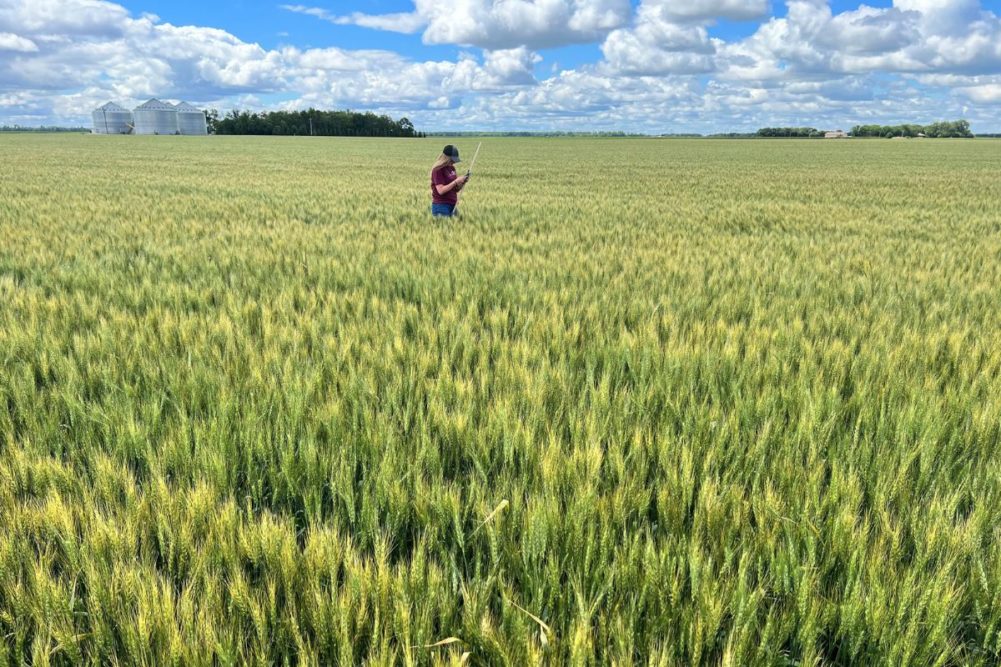FARGO, NORTH DAKOTA, US — Despite weather complications and minor pest and disease challenges, the 2022 US Northern Plains spring wheat crop is thriving and poised for large yields. That was the consensus from more than 50 scouts from across the wheat value chain, academia, government and the media who appraised, measured, calculated and estimated 304 wheat fields in late July.
The Hard Spring and Durum Wheat Quality tour took place across North Dakota and western Minnesota from July 25-28.
The four-day trek wrapped up with scouts departing Devils Lake, North Dakota, US, early Thursday en route back to the tour’s genesis in Fargo, North Dakota, US. At a final meeting held at the Northern Crops Institute on the campus of North Dakota State University, scouts submitted their yield estimates from their Day 3 field stops and discussed their findings. The data from the day’s field stops were added and averaged by Rita Ott of General Mills, the chairwoman of the Wheat Quality Council executive committee for 2022, and combined with data from the previous two days.
The average spring wheat yield for 2022 was estimated at 49.1 bpa, sharply higher than 29.1 bpa estimated in 2021 on the basis of 257 stops.
The average hard red spring wheat yield calculated for the shortened third day of scouting, derived from 44 stops, was 53.1 bushels per acre, up from 35.4 bpa based on 62 stops on the third day of the 2021 tour and compared with 48.6 bpa from 64 stops on Day 3 of the 2019 tour, which is seen as the last normal tour undertaken before the canceled 2020 tour and the moisture-starved crop appraised during the 2021 tour.
The 2022 tour in its entirety comprised 267 hard red spring wheat field stops and 35 durum wheat field checks. The average spring wheat yield for 2022 was estimated at 49.1 bpa, sharply higher than 29.1 bpa estimated in 2021 on the basis of 257 stops. The estimate was the largest since 49.9 bpa in 2015 when a whopping 422 spring wheat fields underwent the measurement and calculation process.
The average 2022 durum wheat yield estimate was 39 bpa, up from 24.3 bpa in 2021 after 15 field stops. The durum yield estimate was the largest since 39.3 bpa in 2018 on the basis of 17 field stops.
In reports issued on Day 3 and throughout the tour, scouts had similar messages. They said the crop was behind normal pace overall and in a wider variety of development phases due to the elongated planting window in which some spring wheat was seeded in April before rainy and at times snowy weather and accompanying cool temperatures moved back in for an extended winter. Planting resumed in fits and starts when conditions allowed, but some fields were seeded as late as June while others fell into the “prevented plant” category.
As a result, fields were farther along in some places. As an example, scouts on the pink route measured three fields the morning of July 28 and found one in hard dough phase, one in soft dough, and one transitioning from milk to dough stage. The estimated time until harvest in fields across the two states ranged widely from three to eight weeks. Most fields were seen at four to six weeks out.
Scouts along the pink route also saw instances of ustilago tritici, aka loose smut, a seedborne fungus that moves into the developing grain tissue and presents as a mass of black spores on spikelets instead of flowering parts. This was a relatively rare sighting on the tour.
Throughout North Dakota and western Minnesota wheat fields, scouts noted some occurrence of fusarium head blight, aka scab, which typically leads to yield loss, lowered test weights, low seed germination, and can contaminate grain with mycotoxin. However, while scab was noted in many fields, it was by no means prevalent, nor did it make up a large portion of the plants.
Prior to the week’s tour, concerns were raised about grasshoppers and their destructive effects on wheat yields. While most scouts encountered them at various times over the course of three days in the field, the occurrence was less than feared, typically characterized by a few specimens near the edge of wheat fields. Most appeared to prefer munching on adjacent fall crops such as soybeans.
The productive, informative tour continued to rebuild attendance levels following the canceled 2020 tour and the 2021 trek across water-deprived wheat fields by a smaller group as COVID continued to rage. The Wheat Quality Council was established in 1938 with a concentration on evaluating hard red winter wheat for milling and end-use quality. An expanded council emerged in 1993-94 when the spring and soft wheat groups were invited under the WQC umbrella.
The 2022 tour was produced under the direction of Dave Green, executive vice president of the Wheat Quality Council, and hosted by wheat industry veteran Brian Walker, retired former technical director at Miller Milling.
The 2022 tour also saw two hard red winter wheat fields measured for an average yield estimate of 27.5 bpa.




